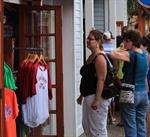HAVE YOU GOT YOUR BUSINESS COSTS RIGHT?

Extract from the ebook
Saving a Business (available in this bookshop).
The costs of a business are a major factor. Look at the costs involved in running your business. Are they too high or are you not spending enough? What costs are there? As a successful business owner you need to know your numbers.
Pricing
What we sell our product or service for is definitely a major part of how successful a business is. If you do not sell your product for the right price, it can impact on your profit.
-
Sell your product too cheaply and you may not make enough profit
-
Sell it too cheaply and customers may think it is not good quality
-
Sell a product at too expensive a price and it may not sell
Finding the optimum price for your product is essential. You need to determine whether the price is right, but how do you work out the right price for a product?
Selling a Service
If you are offering a service, then you can begin by looking at industry recommended standards for hourly rates. You might also find out the range of fees that others in your region are charging for the same, or a similar, service. If you, or your staff, are relatively inexperienced you may begin at the lower end of the price range and gradually increase fees as your business and experience grows.
Someone with specialist skills, or a great deal of experience, would be more likely to charge at the upper end of the range. The important factor here though is not to overcharge. Clients and customers will feel aggrieved if they think they are paying too much for your service, no matter how skilled or qualified you are. Once again, it is a question of striking a balance between what you could or should be charging and what people are happy to pay. Don’t sell yourself short, but don’t overcharge.
Selling a Product
If you are selling products then you have to sell them at a profit to keep your business afloat. If you can buy in bulk, then you can usually buy your products at a lower price and sell them at a lower price if you need to, or you want to make more sales. This is what the big supermarkets and department stores do. It is also why they can put on sales where prices are slashed by up to 70-80%.
When deciding on what to charge for your products, you have to think about:
If you are selling a unique product then you can charge more for it since you have little direct competition. Nevertheless, even if you are selling something unique you need to be careful about not setting your prices too high. If you do, people will source an alternative or simply not buy your product. You also run the risk that others who have observed your high prices will then copy your product and undercut your prices.
If you are the only outlet for a particular product in a particular area then you may be able to set higher charges for the product e.g. a petrol service station in a remote region or the only grocery store in a holiday resort.
Setting the Price
If you sell a wide range of products a simple method of setting the price is to apply the same mar-up to each product. Let’s say product X costs you $10.00. If you were to mark-up all your products by 50% you would sell product X for $10.00 + 50% = $15.00.
This method might be useful if other methods are too complicated but it tells you little about the rest of your business and how well you are doing overall.
Other methods give you more understanding and greater control over price setting. The most crucial thing to know is how much your product costs overall. This will help you to determine how much mark-up to add to your price (and how many you need to sell) in order to make a profit.
The cost of a product is not simply what it costs your business to buy it in the first place. It also includes your fixed costs.
Fixed costs include your overheads e.g. shop rental fees, website fees, staff wages, and so forth. Fixed costs remain the same regardless of sales.
You also have variable costs. These are directly related to sales. They usually go down as sales go down, and up when sales increase. They include things like delivery charges, cost of raw materials and labour, and staff bonuses.
Once you know what your fixed and variable costs are, you can set about working out your break-even point – the point at which sales cover expenses.
- Break-even point = Fixed Costs / Price – Variable Costs
If sales fall below the break-even point then you will make a loss. If they are higher than the break-even point then you will make a profit.
Let’s say your sales begin to drop off and you cannot reach the break-even point then according to the formula there are two options.
In any business, you have to cover your costs in order to continue to sell a product but in the long term you need to make a profit to make it worthwhile.
If you cannot set a profit margin which will make you some money and be competitive in the market place and you cannot cut your costs any further then you may have to drop the product for one you can make more profit on or which has less competition from other products